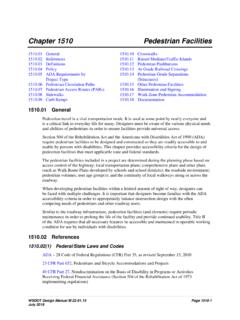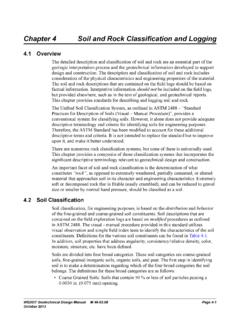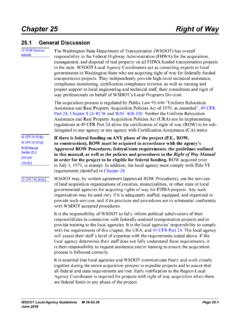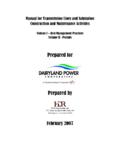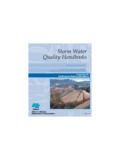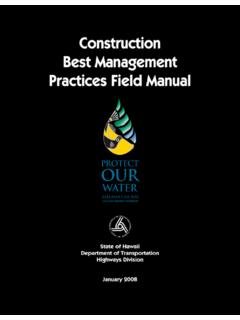Transcription of Division 8 Miscellaneous Construction
1 2018 Standard Specifications M 41-10 Page 8-1 Division 8 Miscellaneous Construction8-01 erosion control and Water Pollution DescriptionThis Work consists of furnishing, installing, maintaining, removing and disposing of high visibility fence, and water pollution and erosion control items in accordance with these Specifications and as shown in the Plans or as designated by the MaterialsMaterials shall meet the requirements of the following sections: Corrugated Polyethylene Drain Pipe (6) Quarry Spalls 9-13 Seed Fertilizer Mulch and Amendments Tackifiers (7) erosion control Devices High Visibility Fence Construction Geotextile 9-33 For all seed the Contractor shall furnish the Engineer with the following documentation:1. The state or provincial seed dealer license and Copies of Washington State Department of Agriculture (WSDA) test results on each lot of seed. Test results must be within six months prior to the date of concrete, in any form, shall not be used for any Work defined in Section Construction (1) GeneralThe Contractor shall install a high visibility fence along the site preservation lines shown in the Plans or as instructed by the the life of the project, the Contractor shall preserve and protect the delineated area, acting immediately to repair or restore any fencing damaged or pollution, erosion , runoff, and related damage requires the Contractor to perform temporary Work items including but not limited to:1.
2 Providing ditches, berms, culverts, and other measures to control surface Building dams, settling basins, energy dissipaters, and other measures, to control downstream Controlling underground water found during Covering or otherwise protecting slopes until permanent erosion - control measures are the degree possible, the Contractor shall coordinate this temporary Work with permanent drainage and erosion control Work the Contract Engineer may require additional temporary control measures if it appears pollution or erosion may result from weather, the nature of the materials, or progress on the natural elements rut or erode the slope, the Contractor shall restore and repair the damage with the eroded material where possible, and remove and dispose of any remaining material found in ditches and culverts. When the Engineer orders replacement with additional or other materials, unit Contract prices will cover the quantities 8-2 2018 Standard Specifications M 41-108-01 erosion control and Water Pollution ControlAll sediment control devices including, but not limited to, sediment ponds, silt fencing, or other sediment trapping BMPs shall be installed prior to any ground disturbing activity.
3 Clearing, grubbing, excavation, borrow, or fill within the Right of Way shall never expose more erodible earth than as listed below, without written approval by the Engineer:Western Washington (West of the Cascade Mountain Crest)Eastern Washington (East of the Cascade Mountain Crest)May 1 through September 3017 AcresApril 1 through October 3117 AcresOctober 1 through April 305 AcresNovember 1 through March 315 AcresThe Engineer may increase or decrease the limits based on project earth is defined as any surface where soils, grindings, or other materials may be capable of being displaced and transported by rain, wind, or surface water earth not being worked, whether at final grade or not, shall be covered within the specified time period (see the table below), using an approved soil covering Washington (West of the Cascade Mountain Crest)Eastern Washington (East of the Cascade Mountain Crest)October 1 through April 302 days maximumOctober 1 through June 305 days maximumMay 1 to September 307 days maximumJuly 1 through September 3010 days maximumIf the Engineer, under Section , orders the Work suspended, the Contractor shall continue to control erosion , pollution, and runoff during the in this section shall relieve the Contractor from complying with other Contract (1)A SubmittalsWhen a temporary erosion and Sediment control (TESC) Plan is included in the Plans, the Contractor shall either adopt or modify the TESC Plan.
4 The Contractor shall provide a schedule for TESC Plan implementation and incorporate it into the Contractor s progress Contractor s adoption of the TESC Plan as shown in the Plans shall be submitted as a Type 1 Working Drawing. Modified TESC Plans shall be submitted as Type 2 Working Drawings, conforming to all requirements of the current edition of the WSDOT Temporary erosion and Sediment control Manual M 3109. The TESC Plan shall cover all areas that may be affected inside and outside the limits of the project (including all Contracting Agency-provided sources, disposal sites, and haul roads, and all nearby land, streams, and other bodies of water).Failure to accept all or part of any such Plan will not make the Contracting Agency liable to the Contractor for any Work (1)B erosion and Sediment control (ESC) LeadThe Contractor shall identify the ESC Lead at the preconstruction discussions and in the TESC Plan. The ESC Lead shall have, for the life of the Contract, a current Certificate of Training in Construction Site erosion and Sediment control from a course approved by the Washington State Department of Ecology.
5 The ESC Lead shall be listed on the Emergency Contact List required under Section (1).The ESC Lead shall implement the TESC Plan. Implementation shall include, but is not limited to:1. Installing and maintaining all temporary erosion and sediment control Best Management Practices (BMPs) included in the TESC Plan to assure continued performance of their intended function. Damaged or inadequate TESC BMP s shall be corrected Updating the TESC Plan to reflect current field Standard Specifications M 41-10 Page 8-3 erosion control and Water Pollution control 8-01 When a TESC Plan is included in the Contract Plans, the ESC Lead shall also inspect all areas disturbed by Construction activities, all on-site erosion and sediment control BMP s, and all stormwater discharge points every calendar week and within 24 hours of runoff events in which stormwater discharges from the site or as directed by the Engineer. Inspections of temporarily stabilized, inactive sites may be reduced to once every calendar month.
6 The erosion and Sediment control Inspection Form (WSDOT Form 220-030) shall be completed for each inspection and a copy shall be submitted to the Engineer no later than the end of the next working day following the (1)C Water ManagementUnless site water is to be managed in accordance with the conditions of a waste discharge permit from a local permitting authority, site water shall be managed as (1)C1 Disposal of Dewatering WaterWhen uncontaminated groundwater with a pH range of is encountered in an excavation on a project covered by a NPDES Construction Stormwater General Permit, it may be disposed of as follows:1. When the turbidity of the groundwater is 25 NTU or less, it may bypass detention and treatment facilities and be discharged into the stormwater conveyance system at a rate that will not cause erosion or flooding in the receiving surface water When the turbidity of the groundwater is not more than 25 NTU above or 125 percent of the turbidity of the site stormwater runoff, whichever is greater, the same detention and treatment facilities as used to treat the site runoff may be When the turbidity of the groundwater is more than 25 NTU above or 125 percent of the turbidity of the site stormwater runoff, whichever is greater, the groundwater shall be treated separately from the site , the Contractor may pursue independent disposal and treatment alternatives that do not use the stormwater conveyance (1)
7 C2 Process WastewaterWastewater generated on-site as a byproduct of a Construction process shall not be discharged to surface waters of the State. Some sources of process wastewater may be infiltrated in accordance with the NPDES Construction Stormwater General (1)C3 Shaft Drilling Slurry WastewaterWastewater generated on-site during shaft drilling activity shall be managed and disposed of in accordance with the requirements below. No shaft drilling slurry wastewater shall be discharged to surface waters of the State. Neither the sediment nor liquid portions of the shaft drilling slurry wastewater shall be contaminated, as detectable by visible or olfactory indication ( , chemical sheen or smell).1. Water-only shaft drilling slurry or water slurry with approved flocculants may be infiltrated on-site. Flocculants used shall meet the requirements of Section (1) or shall be chitosan products listed as General Use Level Designation (GULD) on the Department of Ecology s stormwater treatment technologies webpage for Construction treatment.
8 Infiltration is permitted if the following requirements are met:a. Wastewater shall have a pH of prior to The source water meets drinking water standards or the Groundwater Quality Criteria listed in WAC The amount of flocculant added to the slurry shall be kept to the minimum needed to adequately settle out solids. The flocculant shall be thoroughly mixed into the Infiltration locations shall be at least 100 feet away from surface waters, wells, on-site sewage systems, aquifer-sensitive recharge areas, sole source aquifers, and well-head protection areas. Before infiltration begins, there shall be a minimum of 5 feet of unsaturated soil between the soil surface receiving the wastewater for infiltration and the groundwater surface ( , saturated soil).Page 8-4 2018 Standard Specifications M 41-108-01 erosion control and Water Pollution Controle. The slurry removed from the shaft shall be contained in a leak proof cell or tank for a minimum of 3 Within a 24 hour period, a maximum of 21,000 gallons of slurry wastewater may be infiltrated in an infiltration location.
9 The infiltration rate shall be reduced if needed to prevent wastewater from leaving the infiltration location. The infiltration site shall be monitored regularly during infiltration activity. All wastewater discharged to the ground must fully infiltrate and discharges must stop before the end of each work After infiltration activity is complete, loose sediment in the infiltration location that may have resulted from the infiltration activity or the removal of BMPs used to manage infiltration activity shall be stabilized to prevent mobilization by stormwater Drilling spoils and settled sediments remaining in the containment cell or tank shall be disposed of in accordance with Section (4) Infiltration locations shall be marked on the on-site temporary erosion and sediment control (TESC) plan sheets before the infiltration activity Prior to infiltrating water-only shaft drilling slurry or water slurry with approved flocculants, the Contractor shall submit a Shaft Drilling Slurry Wastewater Manage-ment and Infiltration Plan as a Type 2 Working Drawing.
10 This Plan shall be kept on-site, adapted if needed to meet the Construction requirements, and updated to reflect what is being done in the field. The Working Drawing shall include, at a minimum, the following information:i. Plan sheet showing the proposed infiltration location and all surface waters, wells, on-site sewage systems, aquifer-sensitive recharge areas, sole source aquifers, and well-head protection areas within 150 The proposed elevation of soil surface receiving the wastewater for infiltration and the anticipated phreatic surface ( , saturated soil).iii. The source of the water used to produce the The estimated total volume of wastewater to be The approved flocculant to be used (if any).vi. The controls or methods ( , trenches, traps, berms, silt fence, dispersion, or discharge metering devices) that will be used to prevent surface wastewater runoff from leaving the infiltration location.





